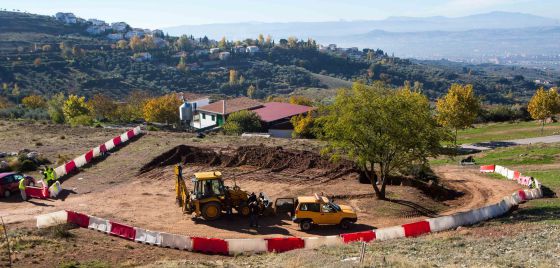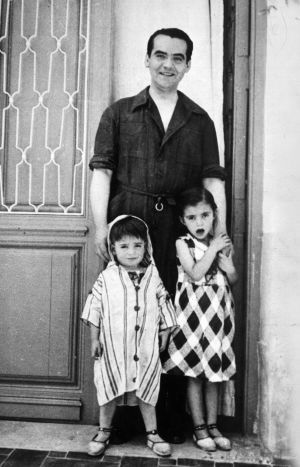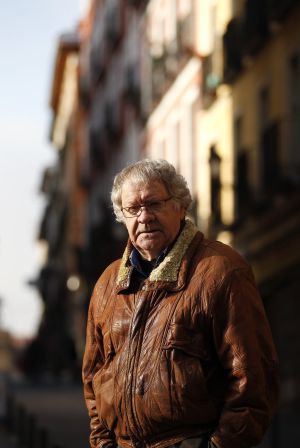
Lorca’s grave: third time lucky?
After two failed attempts, researchers in Granada think they know where the poet is buried
Granada, 27 October 2015
Upon reaching the spot, one cannot help but think of that line from Poema de la Soleá: “Tierra seca, tierra quieta de noches inmensas” (Dry land, quiet land of immense nights). If ever there was a genius who was able to create unsettlingly premonitory work, it was Federico García Lorca.
Somewhere beneath the dry land of what is now Plot No.9 in Alfacar (Granada), a barren wasteland of weeds and rocks, within a 160-meter radius – that is where the body of the playwright and poet might be.
So say Miguel Caballero and Javier Navarro, heads of the research team looking for the exact location of Lorca’s grave.
Now we have to look for a needle in a haystack. If everything had been left the way it was, we would have found the remains already”
MIGUEL CABALLERO, HEAD RESEARCHER
The search is about to enter a new phase after the Andalusian government granted permission to seek out the place where the author of Poet in New York and Blood Wedding was buried, together with other victims of a firing squad on August 17, 1936, at the beginning of the Spanish Civil War.
A bevy of historians, archeologists, geologists and forensic experts from Spain, Argentina and Britain are waiting their turn to dig. It will be the third attempt to find Lorca’s grave. Two earlier and much-publicized attempts both ended in failure.
The first try was in 2009, and was based on a lengthy investigation by the renowned historian and Hispanist Ian Gibson, who has written extensively about Lorca. There was a second attempt last year by the same team that is about to try again, just a few meters away from where they left off.
Blame it on the cold weather. Winter came around, and the digger that was being used at the site was required elsewhere for snow-removal duties. Or perhaps there just wasn’t enough political will to carry through with the plans. But the attitude seems to be changing, both at the local and regional levels.
The project’s finances have also improved greatly thanks to a global crowdfunding drive that attracted many donors, some anonymous. This came on top of the €16,500 in unspent money left over from a grant provided by the Andalusian government in 2014.
This time, Miguel Caballero and dig director Javier Navarro are confident that they will be successful.
“If they are there, we will find them,” says Navarro, in reference to Lorca and to the teacher and two bullfighter’s assistants who were shot and buried with him. “We’ve made progress on our knowledge of the ground, with scientific work that has ruled out certain spots.”

Their search is based on information that differs significantly from that used by Ian Gibson as reference.
“Our reference is the work by the Granada researcher Eduardo Molina Fajardo, published posthumously in 1983,” they say. That document, titled Los últimos días de García Lorca (or, The last days of García Lorca) was written by a man who supported the Franco side and featured testimony by people involved in the crime, besides containing a wealth of data regarding places and times provided by direct witnesses.
The son of one of the people named in the book has certified the relevance of the new investigation. Fernando Nestares, a retired general, was taken to the spot of the execution by some of the people whom he says participated directly in it.
“There were three of them,” says General Nestares. “I was taken by the assault guards to the place where they said they had killed them. One of them was named Antonio Benavides and he was a real show-off.”
According to Nestares, the victims were brought there in two trucks: “One was transporting García Lorca and the anarchist banderilleros [bullfighter’s assistants] Juan Arcoya Cabezas and Francisco Galadí. The other one was carrying Dióscoro Galindo, a republican teacher from Publiana, who was also executed.”
Some members of the firing squad were recruited for their accurate aim, while others joined out of personal pleasure
Some members of the firing squad were recruited for their accurate aim, while others, like Antonio Benavides, joined out of personal pleasure, according to Miguel Caballero, who defined him as a natural-born killer.
Meanwhile, Ian Gibson had based his research on testimony by Manuel Castilla Blanco, aka “Manolillo the Communist,” who allegedly buried the bodies. He led Gibson to a different spot around 400 meters from the current dig site.
Miguel Caballero has stated that this man’s testimony is not to be trusted, as he arrived in Alfacar in September 1936 – the crime was committed in August. “In those times of need, anybody was willing to offer a version of events in exchange for something.”
But Gibson is adamant. “Taking a foreigner there in those days was risky. I think he was there. He was convinced that he was telling me the truth.”

The trouble with the new spot, which has been closed off with stakes, is that it is covered with around eight meters of earth due to earlier plans for a soccer field. On the same spot where researchers believe that Lorca is buried, there was once a training ground for Franco’s forces, then a motocross circuit, and finally plans for a residential estate and sports complex.
But Isabel García Lorca, the poet’s sister, campaigned to stop the construction project and wrote to the mayor in October 1998. She also sent a fax to the Andalusian premier, then Manuel Chaves. The plans were halted.
“But the main damage had already been done,” says Caballero, referring to the fresh layer of earth. “Now we have to look for a needle in a haystack. If everything had been left the way it was, we would have found the remains already.”
English version by Susana Urra.


No comments:
Post a Comment